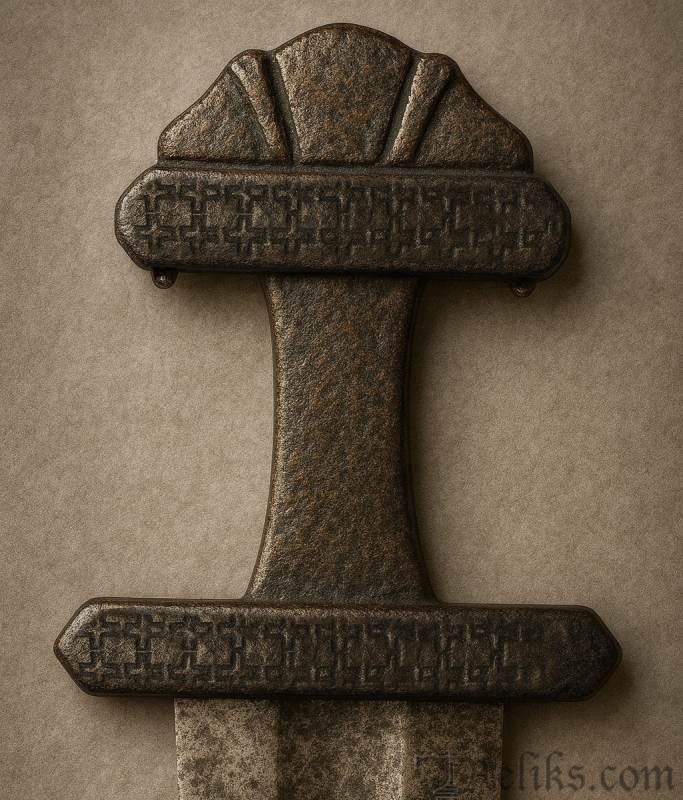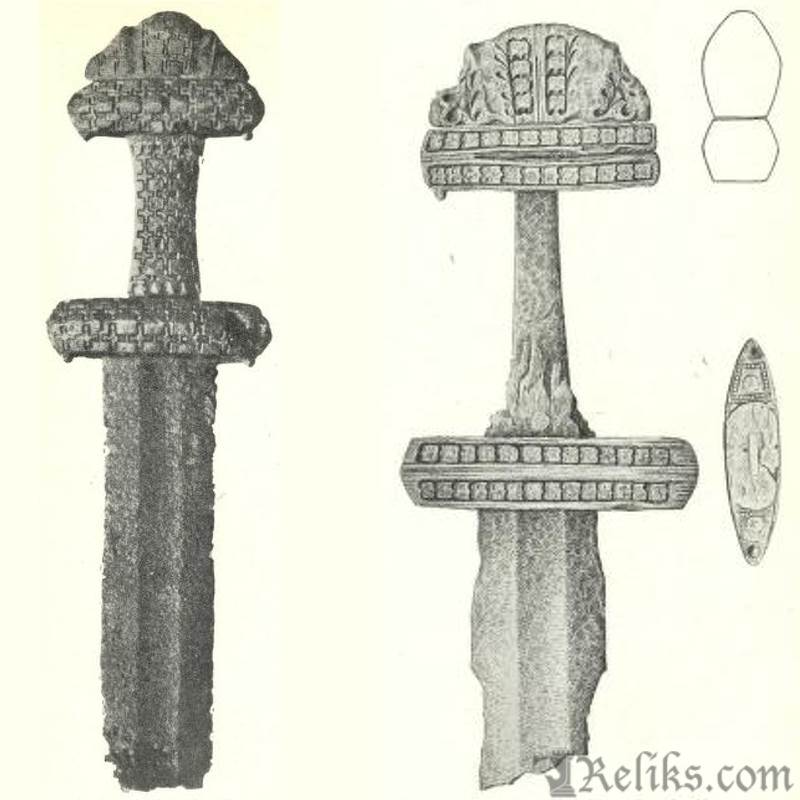Viking Sword Type D – Ornamented Power of the Early Viking Age
From Mass to Majesty
If Type C swords impressed with their sheer size and weight, Type D took that power and turned it into spectacle. With richly ornamented hilts, intricate metal inlays, and massive forms, Type D swords stand among the most magnificent weapons of the early Viking Age. These were not just weapons — they were symbols of prestige, authority, and craftsmanship.
Archaeological Description

Viking Sword Type D – Ornamented Power of the Early Viking Age
Type D swords feature large, ridged guards with tapering cross-sections and a three-part pommel, highest at the center. Both the guards and pommel are richly decorated: alternating recessed and raised panels often filled with bronze or copper inlays, while the raised fields remained iron.
Patterns vary widely:
- Rows of small bronze knobs, possibly stylized animal heads.
- Cross-shaped figures along the guard or pommel.
- Square panels filled with raised studs.
- Occasionally, a bronze collar (vettrim) of opposed animal heads appears above or below the guard.
Many swords display prominent rivet heads, often large, securing the hilt, and in some cases the tang itself was covered with decorative metal plating.
The guards could reach 3.4 cm high, with pommels up to 4 cm, making for an imposing upper guard. Though no blade survives intact, Petersen weighed examples at 1.35–1.47 kg, marking them among the heaviest Viking Age swords. With their broad, ornate hilts, they strike a balance between heaviness and splendor.

Petersen Sketches (fig.59-60)
Relationships to Other Types
Type D follows Type C but with greater ornamentation and refinement. It shares the heavy, massive form but adds rich decorative schemes, sometimes influenced by continental and eastern styles. Petersen and later scholars noted clear similarities with Hungarian examples, suggesting at least some foreign inspiration.
Yet, not all Type D swords are imports — many were likely made in Norway, adapting continental styles to local tastes. The presence of riveted bronze collars, animal motifs, and unique inlay patterns show how foreign ideas were reinterpreted in Scandinavian workshops.
Historical & Cultural Context
Type D belongs to the early Viking Age, particularly the first half of the 9th century. This was the height of the Viking expansion into Ireland, Scotland, and the Frankish world, and the swords reflect this wider cultural contact.
Ornamentation was not mere decoration. The use of bronze, copper, and animal motifs tied these swords into a tradition of prestige weaponry, where a chieftain’s blade symbolized not only martial ability but also wealth and alliances. Finds in Ireland and Scotland show that such swords traveled widely, either through trade, gift exchange, or battlefield capture.
Distribution and Finds
Petersen documented 11 examples in Norway, distributed fairly evenly across the country, though absent from the far north. Notable finds include Moss (Østfold), Vang (Hedmark), Brandbu and Vågå (Oppland), Mandal, Stavanger, Fjellberg, Gloppen, and Telemark.
Outside Norway, Type D swords have been found in:
- Ireland (Kilmainham near Dublin, plus others with bronze collars and ornamented studs).
- Scotland (Isle of Eigg).
- Sweden (Södermanland).
- Denmark (Vendsyssel, Jutland).
- Hungary (parallels with richly ornamented examples).
This wide distribution shows that Type D was both a Scandinavian type with local roots and part of a broader pan-European exchange of styles in the early 9th century.
Associated finds include axes of Type D, spearheads of Types E and F, shield bosses of R 564, and older rattles. These combinations consistently point to an early Viking Age context, with some examples possibly extending into the later 9th century.
For Collectors and Enthusiasts
For modern enthusiasts, Type D represents the ornamental high point of early Viking swords. Its lavish inlays, animal motifs, and sheer bulk make it one of the most visually striking sword types. Surviving specimens are rare and fragile, often fragmentary, but their presence in Irish and Scottish collections demonstrates how far these swords traveled.
Collectors and reenactors admire Type D for its bold design, though reproductions are complex and costly due to the intricate metalwork. For museums, a Type D sword is a centerpiece — a tangible symbol of Viking wealth and craftsmanship.
Closing Reflection
Type D shows us that Viking swords were not only functional tools of war but also statements of status and cultural exchange. While Type A and B were plain and transitional, and Type C heavy and local, Type D is international, ornate, and unmistakably Viking. It embodies the warrior-chieftain elite of the 9th century — men whose blades were as much about identity and power as about combat.
Core classification based on Jan Petersen, De Norske Vikingesverd (1919). Additional commentary by Reliks.com.